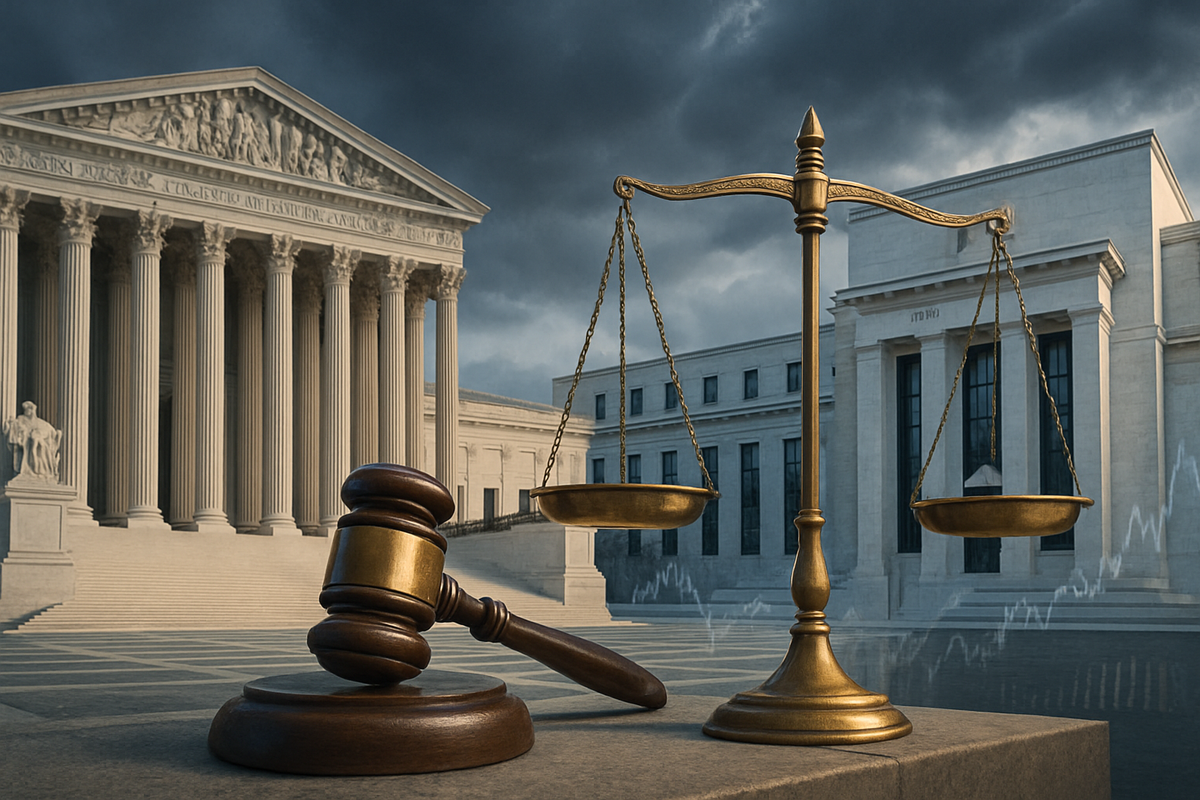
The U.S. financial landscape witnessed a pivotal moment today, October 1, 2025, as the Supreme Court issued a critical ruling concerning the tenure of Federal Reserve Governor Lisa Cook. In a move widely interpreted as a temporary safeguard for the central bank's independence, the highest court in the land blocked an emergency request by the Trump administration to immediately remove Governor Cook. This decision ensures her continued presence on the influential Board of Governors, at least until oral arguments are heard in January 2026, thereby preserving the current composition and perceived stability of the Federal Reserve for the foreseeable future.
The ruling sends a clear signal that the judiciary is prepared to scrutinize executive power over nominally independent agencies, particularly the Federal Reserve, which plays a crucial role in steering the nation's economy. While not a final verdict on the president's authority to dismiss a Fed governor, the delay averts immediate disruption and allows Governor Cook to participate in upcoming monetary policy discussions, providing a measure of continuity amidst ongoing political pressures.
Supreme Court Intervenes in High-Stakes Battle for Fed's Future
The Supreme Court's intervention on October 1, 2025, came in the form of an unsigned order, which notably declined the Trump administration's urgent plea to immediately terminate Governor Cook's position. Instead, the Court decided to grant Cook a temporary reprieve, allowing her to remain in office while setting the stage for full oral arguments in January 2026. This deferral means the complex legal question of a president's authority to remove a Fed governor and whether lower courts can block such dismissals will be thoroughly debated in the coming months, rather than decided hastily.
The roots of this judicial showdown trace back to August 2025, when the Trump administration initiated efforts to remove Governor Cook, citing allegations of mortgage fraud that predated her appointment to the Federal Reserve Board. However, these claims have been vehemently denied by Governor Cook, and previous rulings by lower courts consistently sided with the principle that a Federal Reserve Governor can only be dismissed "for cause" related to misconduct during their active term in office. Governor Cook was initially appointed in May 2022 and subsequently reappointed in September 2023 for a full term slated to conclude on January 31, 2038, highlighting the long-term implications of any decision regarding her tenure.
Key players in this unfolding drama include Governor Lisa Cook herself, whose professional integrity and independence are at the heart of the dispute, and the Trump administration, which sought to exert executive authority over a crucial independent body. The Supreme Court, as the ultimate arbiter, now holds the balance of power, with its upcoming deliberations poised to define the boundaries of presidential influence over the Federal Reserve. Initial reactions from financial markets have been largely one of relief, with observers noting that the temporary resolution avoids immediate uncertainty regarding the Fed's leadership, contributing to a sense of stability in an otherwise politically charged environment. Esteemed former Federal Reserve chairs, including Alan Greenspan, Ben Bernanke, and Janet Yellen, had previously submitted an amicus brief warning the Supreme Court against immediate removal, emphasizing the potential erosion of public confidence in the Fed's independence and the credibility of U.S. monetary policy.
Market Implications: Stability Favors Growth, Uncertainty Looms
The Supreme Court's decision to delay the removal of Federal Reserve Governor Lisa Cook has created a temporary period of stability within the Fed's leadership, which is generally viewed positively by financial markets. This continuity can have several implications for public companies across various sectors, particularly those sensitive to interest rates and economic policy.
Companies in the banking sector, such as JPMorgan Chase & Co. (NYSE: JPM) and Bank of America Corp. (NYSE: BAC), may experience a period of reduced volatility. A stable Federal Reserve board implies a more predictable monetary policy outlook, which is crucial for banks that rely on interest rate differentials for their profitability. Any sudden, politically motivated changes to the Fed's composition could lead to market speculation about abrupt shifts in interest rate policy, potentially impacting lending environments and bond yields. With Governor Cook remaining, the current policy trajectory, which aims for price stability and maximum employment, is likely to continue without immediate disruption, providing a stable operating environment for financial institutions.
Conversely, sectors that thrive on uncertainty or benefit from rapid policy shifts might see fewer immediate opportunities. For instance, some alternative investment firms or hedge funds that profit from market dislocations might find the current stability less conducive to their strategies. However, the underlying uncertainty of the upcoming January 2026 oral arguments means that this period of calm is merely a pause, and these firms will be closely watching for future volatility. Technology companies, often valued on future earnings and sensitive to discount rates, like Apple Inc. (NASDAQ: AAPL) or Microsoft Corp. (NASDAQ: MSFT), also benefit from a stable interest rate environment, as it allows for more accurate long-term financial planning and investment decisions.
The broader market perception of the Fed's independence is a critical factor for investor confidence. Companies that rely on robust capital markets for funding and expansion, such as growth-oriented startups or firms undergoing significant capital expenditure, indirectly benefit from the Supreme Court's stance. A strong, independent Fed is perceived as a bulwark against inflation and economic instability, reassuring investors that their capital is protected. The delay in Cook's removal helps to maintain this perception, at least for now, preventing a sudden shock that could dampen investment appetites and potentially raise the cost of capital for many businesses.
Broader Significance: Preserving Institutional Independence
The Supreme Court's decision reverberates far beyond the immediate fate of Governor Lisa Cook, touching upon the fundamental principle of central bank independence and its role in broader industry trends. This event underscores a global discussion about the appropriate balance between political accountability and the autonomy required for monetary policymakers to make impartial, long-term economic decisions. Many developed and emerging economies rely on the credibility of their central banks to manage inflation and financial stability, and any perceived erosion of this independence can have significant ripple effects.
Internationally, the ruling sends a message to global financial markets and foreign governments regarding the institutional strength of the United States. A weakened Federal Reserve, susceptible to political pressures, could undermine confidence in the U.S. dollar and the stability of the world's largest economy. This could lead to increased volatility in currency markets and potentially impact international trade and investment flows. Competitors and partners alike will be closely watching the developments, as the stability of the U.S. financial system is interconnected with the global economic order. For instance, major international banks like HSBC Holdings plc (LSE: HSBA) or Mitsubishi UFJ Financial Group, Inc. (TYO: 8306) have significant exposure to the U.S. market and would be sensitive to any perceived weakening of its core financial institutions.
From a regulatory and policy perspective, the case holds immense implications for the scope of presidential power over independent agencies. A definitive ruling in January 2026 could set a precedent for how future administrations interact with not only the Federal Reserve but also other critical bodies like the Securities and Exchange Commission (SEC) or the Federal Communications Commission (FCC). This could redefine the checks and balances within the U.S. government structure, potentially altering the landscape for regulatory enforcement and policy implementation across various industries.
Historically, clashes between the executive branch and the Federal Reserve are not unprecedented. While direct attempts to remove a sitting Fed Governor have been rare, tensions over monetary policy and the Fed's independence have periodically surfaced. This current situation draws parallels to past debates where presidents sought to influence Fed policy, highlighting a recurring tension between political objectives and the Fed's mandate for non-partisan economic stewardship. The Supreme Court's engagement in this matter elevates its significance, potentially establishing a landmark legal interpretation of the "for cause" removal standard for independent agency heads.
What Comes Next: Awaiting a Landmark Decision
The Supreme Court's decision to delay a final ruling on Governor Lisa Cook's tenure sets the stage for a critical legal and economic showdown in the coming months. In the short term, Governor Cook will continue to serve on the Federal Reserve Board, participating in upcoming Federal Open Market Committee (FOMC) meetings scheduled for the remainder of 2025. Her presence ensures continuity in policy discussions and decisions, particularly as the Fed navigates ongoing economic conditions, including inflation management and labor market dynamics. This period allows for a more measured approach to monetary policy, free from immediate, politically induced disruptions.
Looking ahead to January 2026, the oral arguments before the Supreme Court will be intensely scrutinized. The outcome of these arguments will not only determine Governor Cook's long-term fate but, more significantly, could establish a profound legal precedent regarding the President's authority to remove officials from independent agencies. A ruling that broadly expands presidential removal power could fundamentally alter the institutional independence of the Federal Reserve, potentially leading to increased political influence over monetary policy in future administrations. Conversely, a ruling that reinforces the "for cause" standard would bolster the Fed's autonomy, strengthening its ability to make decisions based purely on economic data and its dual mandate.
For financial markets, this period of anticipation presents both challenges and opportunities. While the current stability offers a reprieve, the looming uncertainty of the January ruling could introduce volatility, particularly in sectors highly sensitive to interest rate expectations and economic policy. Investors may adopt a cautious stance, closely monitoring legal developments and their potential implications for the Fed's long-term policy outlook. Strategic pivots might be required for companies and investors to adapt to potential shifts in the regulatory and economic landscape. Market opportunities could emerge for those adept at navigating policy uncertainty, while challenges will arise for those unprepared for potential changes in the Fed's operational independence.
Potential scenarios range from a definitive reaffirmation of Fed independence, which would be widely welcomed by markets, to a more constrained view of the Fed's autonomy, which could trigger significant market reassessments. The precise wording and scope of the Supreme Court's eventual ruling will be paramount, shaping not only the future of Federal Reserve governance but also the broader relationship between the executive branch and other independent regulatory bodies.
Comprehensive Wrap-up: A Critical Juncture for Fed Independence
The Supreme Court's decision on October 1, 2025, to temporarily block the removal of Federal Reserve Governor Lisa Cook marks a critical juncture in the ongoing debate over central bank independence. The immediate takeaway is one of preserved stability for the Fed's Board of Governors, ensuring Governor Cook's participation in crucial monetary policy decisions at least until early 2026. This temporary reprieve has averted immediate market disruption and reinforced the perception that the judiciary is a vital check on executive power concerning independent agencies.
Moving forward, the market will remain acutely focused on the Supreme Court's oral arguments scheduled for January 2026. The eventual ruling will have lasting implications, not just for the composition of the Federal Reserve but for the very definition of its autonomy and its ability to conduct monetary policy free from political interference. A strong, independent Fed is widely considered essential for maintaining economic stability, controlling inflation, and fostering investor confidence. Any perceived weakening of this independence could lead to heightened market volatility and impact long-term economic planning for businesses and consumers alike.
Investors should closely watch for any signals emerging from the Supreme Court leading up to the January arguments, as well as the reactions of key financial institutions and economic commentators. The decision will shape the landscape for public companies by influencing interest rate expectations, regulatory environments, and overall economic predictability. The long-term significance of this event lies in its potential to either solidify or challenge the historical understanding of the Federal Reserve as an independent arbiter of U.S. monetary policy. The integrity and efficacy of the nation's economic stewardship hang in the balance.
This content is intended for informational purposes only and is not financial advice





